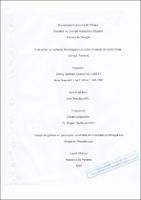Evaluación de bacterias fitopatógenas en cinco hortalizas en Cerro Punta, Chiriquí, Panamá.
Date
2022Author
Guerra Hils, Emerly Sacheen
Luis Trotman, Javier Reynaldo
Metadata
Show full item recordAbstract
La producción de alimentos a nivel mundial cada año registra un aumento,
resultado del incremento de la población y de la demanda de productos con
Elevados niveles de inocuidad. Las hortalizas son uno de los rubros de mayor
Consumo a nivel nacionales Panamá. Los cultivos son amenazados desde sus
inicios por distintos organismos algunos de ellos ocasionan daños superficiales
en las hortalizas, lo que reduce su calidad, apariencia y provoca rechazo por el
consumidor. Las pérdidas en poscosecha de vegetales frescos registran
incrementos significativos, resultantes de técnicas inadecuadas de
almacenamiento e incidencia de microorganismos que reducen su calidad y vida,
causando pérdidas de hasta 50 % en los países en vías de desarrollo (Corrales,
2018). El presente estudio, tuvo por objetivo evaluar bacterias fitopatógenas
presentes en hortalizas poscosecha en el corregimiento de Cerro Punta, provincia
de Chiriquí, Panamá. Los muestreos se realizaron en sitios de expendio y
Distribución, donde se encontraba mayor manejo de las hortalizas en estudio. Se
conectaron 15 muestras de distintos tipos de hortalizas (lechuga, brócoli, repollo,
zanahoria y cebolla) para consumo humano, que presentaban síntomas de ataque
por bacterias. El aislamiento e identificación de especies bacterianas se realizó
mediante pruebas de reacción bioquímica, sistema MicroScan® y recuento en
placa por dilución. Fueron aisladas 10 cepas bacterianas correspondientes a
especies de los géneros Klebsiella, Proteus, Enterobacter y Escherichia, en el
conteo bacteriano se obtuvo un rango de 103 -- 107 UFC/g de hortaliza
Investigaciones previas no han reportado estos géneros como agentes
fitopatógenos causantes de enfermedades en estos cultivos, sin embargo, estos
microorganismos podrían considerarse como contaminantes en la superficie de
las hortalizas en poscosecha, y su elevada carga microbiana indica una
inadecuada calidad microbiológica, representando una fuente de enfermedades
transmitidas por alimentos (ETA's) si la contaminación no es controlada mediante
Buenas prácticas de higiene. Finalmente, no se estableció una relación clara entre
los microorganismos encontrados, con los daños o síntomas en las hortalizas de
Estudio.
Palabras clave: Bacterias fitopatógenas, Enterobacter, Escherichia coli,
hortalizas, inocuidad, Klebsiella, poscosecha, Proteus. Food production worldwide each year registers an increase, as a result of the
growth in population and the demand for products with high levels of safety.
Vegetables are one of the items with the highest consumption at national levels
Panama. Crops are threatened from the beginning by different organisms; some
of them cause superficial damage to vegetables, which reduces their quality,
appearance and causes rejection by the consumer. Postharvest losses of fresh
vegetables register significant increases, resulting from inadequate storage
techniques and the incidence of microorganisms that reduce their quality and life,
causing losses of up to 50 % in developing countries (Corrales, 2018). The
objective of this study was to evaluate phytopathogenic bacteria present in
postharvest vegetables in the county of Cerro Punta, Chiriqui province, Panama.
The samplings were carried out in places of sale and distribution, where there was
greater handling of the vegetables under study. 15 samples of different types of
vegetables (lettuce, broccoli, cabbage, carrot and onion) for human consumption
were collected. which showed symptoms of attack by bacteria. The isolation and
identification of bacterial species was performed using biochemical reaction tests,
the MicroScan® system, and plate count by dilution. Ten bacterial strains
corresponding to species of the genera Klebsiella, Proteus, Enteracter and
Escherichia were isolated in the bacterial count, a range of 103 -- 107 CFU/g of
vegetables was obtained. Previous research has not reported these genera as
phytopathogenic agents that cause diseases in these crops, however, these
microorganisms could be considered as contaminants on the surface of
postharvest vegetables, and their high microbial load indicates an inadequate
microbiological quality, representing a source of foodborne illnesses if the
contamination is not controlled by good hygiene practices. Finally, a clear
relationship was not established between the microorganisms found, with the
damage or symptoms in the studied vegetables.
Keywords: Phytopathogenic bacteria, Enterobacter, Escherichia coli, vegetables,
harmlessness, Klebsiella, postharvest, Proteus.

